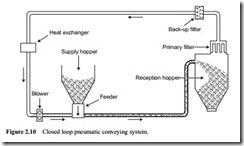Closed systems
The systems illustrated above have all been open systems in which air is usually the conveying gas and this is simply drawn from the atmosphere and returned back to it, after being filtered. For certain conveying duties, however, it is necessary to convey the material in a strictly controlled environment. If a dust cloud of the material is potentially explosive, nitrogen or some other gas can be used to convey the material. In an open system such environmental control can be very expensive, but in a closed system the gas can be re-circulated and so the operating costs, in terms of inert gas, are significantly reduced.
If the material to be handled is toxic or radioactive, it may be possible to use air for conveying, but very strict control would have to be maintained. A closed system would be essential in this case, and probably designed to operate entirely under vacuum. Continuous conveying systems are probably the easiest to arrange in the form of a closed loop. A sketch of a typical system is given in Figure 2.10.
A null point needs to be established in the system where the pressure is effectively atmospheric and provision for make-up of conveying gas can be established here. If this is positioned after the blower the conveying system can operate entirely under vacuum. If the null point is located before the blower it will operate as a positive pressure system.
A back-up filter would always be recommended, because positive displacement blow- ers are very vulnerable to damage by dust. This is simply a precaution against an element in the filter unit failing. There will generally be an increase in temperature across a blower, and in a closed loop system it may be necessary to include a heat exchanger, otherwise there could be a gradual build-up in temperature. The heat exchanger can be placed either before or after the blower, depending upon the material being conveyed.
